The Sailing Museum’s Exhibits Make Sailors Want More
I am no stranger to sailing and maritime museums. I have coerced my wife into visiting institutions devoted to sailing and the sea on over three continents. Halsey Herreshoff himself gave me a behind the scenes tour of the Herreshoff Marine Museum in Bristol, RI. Aussie 18-footer Squadron commodore Ian Smith explained the intricacies of sailing these over-canvassed rocket ships while visiting Sydney’s Darling Harbour Maritime Museum. SailGP and Emirates Team New Zealand skipper Peter Burling helped me pilot a foiling 50-foot catamaran in a simulator during a visit to the team’s Auckland base. And I’ve joined America’s Cup Inspire Youth as they completed a series of hands-on sailing challenges in the Exhibition area of the America’s Village in Bermuda.
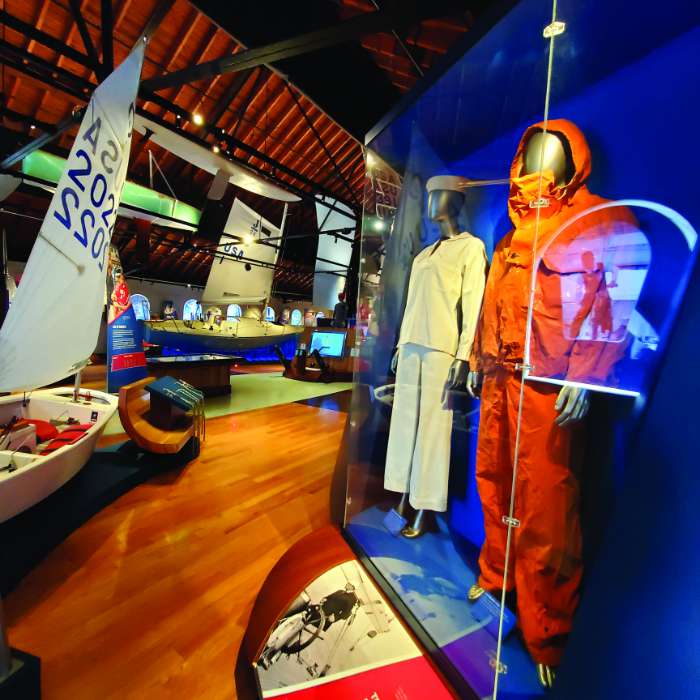
Each experience was unique and added to my knowledge of sailing, but to be honest, none of my previous experiences prepared me for a visit to the one-year-old Sailing Museum in Newport, RI. The museum, built inside a 130-year-old building on Newport’s iconic waterfront that once housed the press office of the America’s Cup, is one sailing experience not to be missed.
Edu-tainment
Shouts of “Hey, this is really cool,” “Watch out, I’m coming through,” “Whew—grinding is hard work,” and other exclamations of exhilaration fill the cavernous 8000-square-foot exhibit space with the sounds of discovery, excitement, and joy.
“We call our museum experience edu-tainment” says newly appointed executive director Ashley Householder, who took over the position in early June. Prior to obtaining her new position, she served two years as the museum’s director of exhibits.
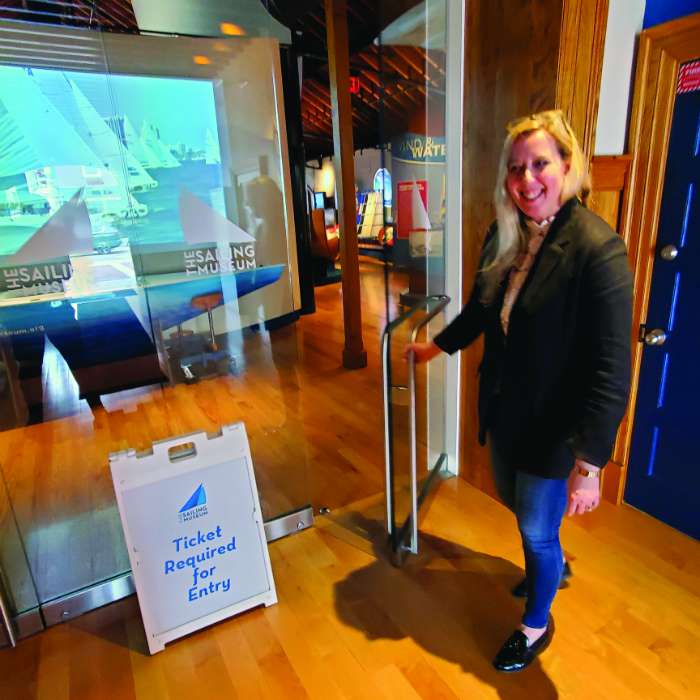
“We have 14 interactive exhibits. Our goal with everything we do is to bring the sailing experience to life in such a way that old salts and newbies alike will come away from their time with us scratching their heads in amazement at what they have just experienced and wanting to come back for more either in an educational environment or actually out on the water with their hands on a real tiller,“ says Householder.
Sailing Museum board of directors co-president and American’s Cup winner Gary Jobson echoes her emphasis on hands-on learning. He says, “The goal is to create a living memorial to all the sailors who have come before us and to inspire new generations to take up the sport we love so dearly.”
Jobson is pleased with the result of the Newport facility: “The Sailing Museum and National Sailing Hall of Fame has surprised visitors from around the USA about the stories, artifacts, and interactive displays that explain the sport of sailing and the inspiring stories of the inductees of the National Sailing Hall of Fame and the America’s Cup Hall of Fame. People of all ages and levels of sailing experience will find many things of interest. The place is great fun to visit. For me, the project has extended 20 years, and it is heartwarming to see it finally open. Everyone is welcome and comes away impressed about the sailors and the sport.”
The facility cost over $9 million. Jobson is proud to say, “We opened our doors almost entirely debt-free.”
The museum incorporates a number of interactive displays and hands-on-learning experiences all packaged in a user-friendly, high-tech experience. Not to be given short shrift, there is an impressive interactive wall of honor in the back that pays homage to National Sailing Hall of Fame and America’s Cup Hall of Fame honorees. Just touch the screen to navigate through the world of sailing’s greats.
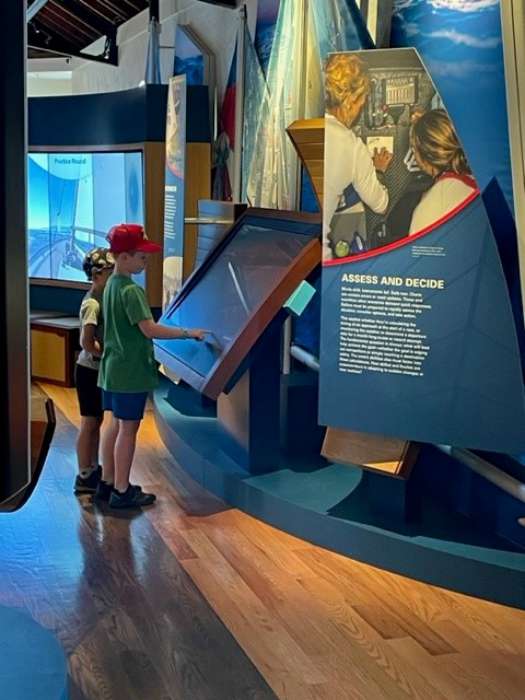
Beginning your journey
Your journey into the world of Wind and Water starts at the first station as you enter the museum. Here, you will be met by a visitor experience associate who will introduce you to the exhibits you will be viewing and interacting with. Be sure to fill out the information at this station so that the QR-coded wrist band you got when you bought your ticket can be your passport to learning as you work your way counterclockwise around the exhibit hall.
One of the first things you’ll do is select a boat type that will be your avatar as you go through the exhibits. Interactive stations will guide you through the design process. You can even name your boat and create your own burgee.
The main hall of the museum is divided into six thematic areas: Wind and Water; The Making of a Champion: Mental; The Making of a Champion: Physical; Teamwork; Competition; and Legends of Sailing—National Sailing Hall of Fame and America’s Cup Hall of Fame.
Other stations emphasize navigation, boat handling, teamwork, onboard stability, and physicality.
At the popular tiller station, for example, visitors get the chance to steer a virtual course using a tiller and understand the forces of wind and water on the course of their boat. Their performance in steering a course is recorded by sensors so visitors can see how they ranked among other “sailors” undergoing the same trial.
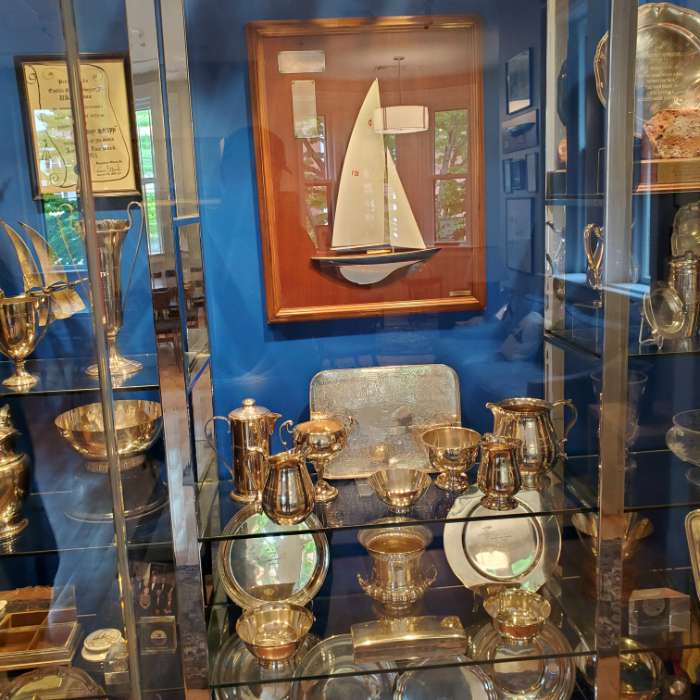
A really cool virtual reality is a video dome where guests “hop aboard a SailGP F-50 catamaran,” our guide Mike Gillis, told us. “That’s a rush. Going over 40 miles per hour in a sailboat is amazing. Hang on!”
Eighty-something catboat sailor Paul Swigert and his wife Shane were among the visitors your reporter caught up with at the museum. Swigert, a rocket-scientist turned sailor, was impressed with the degree of interactivity the staff was able to pack into the exhibits.
He says, “I was brought up to believe that museums were static places for dusty exhibits. This museum breaks all the rules. Here, they want you to put your hands on the exhibits. You won’t see many signs saying ‘Don’t touch’ here.”
Swigert was particularly impressed with the helming station where just the slightest deviation in course was recorded in your digital logbook.
Grind, grind, grind!
Your reporter couldn’t wait to try his hand at the grinding station. I had just finished interviewing Sail GP and America’s Cup grinder Cooper Dressler several months ago in Australia. He told me he maintained a heartbeat of around 175 and a power output of 1000 watts for the extent of a 10-minute sprint. I was eager to see how I would stack up. Ugh. Truth be told, I could hit the heartbeat mark for 30 seconds but couldn’t come close to the watt output even at peak exertion. Don’t know how those guys do it!
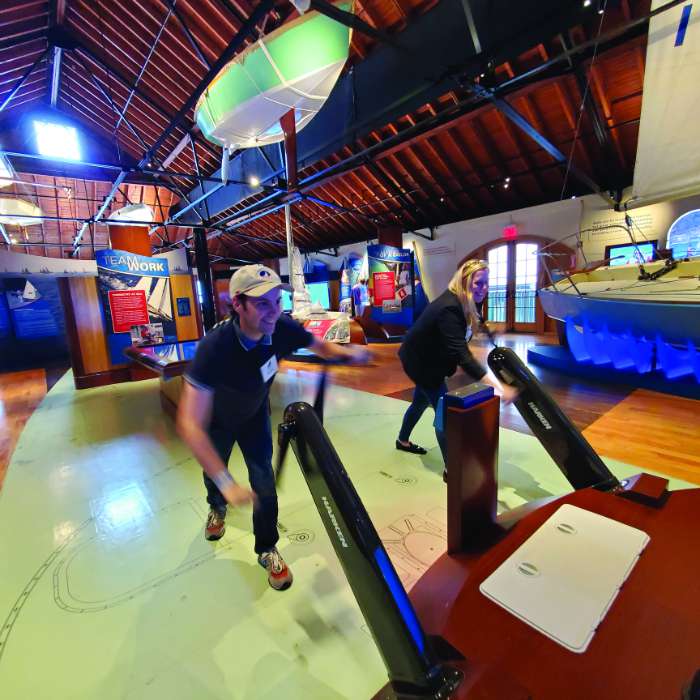
My wife Colleen did a stint at the University of Missouri as a museum docent. She was particularly impressed with the hands-on aspects of the Sailing Museum. “Kids and grandparents can get a real feel for what the sport of sailing is all about,” she says. “I wish my husband knew half of this stuff. We’d still be sailing together if he spent more time here learning the mechanics.”
Our tour of the museum took a little over two hours. We could have spent longer, but the allure of the shops and oyster bars of the Newport waterfront awaited.
As we engaged with the interactive exhibits, we logged our activities in our digital sailing locker. At the end of our tour, we could see how well we performed in the skill sections of the museum. Colleen and Paul were the rock stars of our group. I brought up the rear. At the conclusion of our tour, we could interact with a resource map to identify places to go for sailing instruction and additional on-water experiences.
The museum has partnered with New England Science and Sailing Foundation (NESS) to develop a core curriculum to be used in STEM classwork with a local school. Householder reports that the first trial of the program with 60 sixth-grade students was received enthusiastically by students and teachers.
Learn more
The Sailing Museum is open 10 a.m. to 5 p.m. every day during the summer and fall. Winter hours start in December. The museum is closed for the month of January. Admission costs $18 for adults; $15 for seniors, military, and college students; $12 for youth 11-18; and free for children under 10. Check the website for special exhibits and current hours. Annual memberships start at $50. Member benefits include special programming and advance notice of museum events. Go to thesailingmuseum.org for more details.
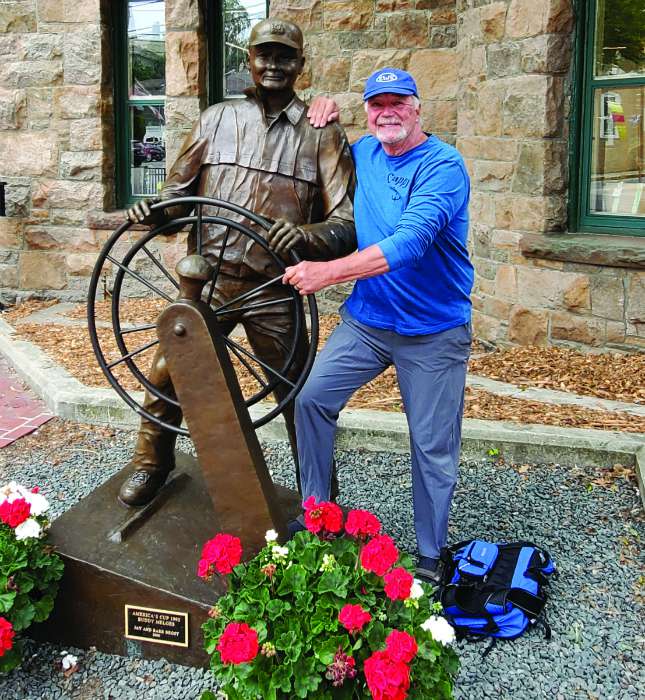
~by Craig Ligibel
Find more destinations for sailors here.




